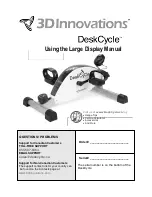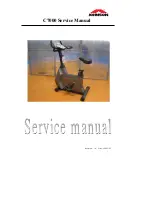
4
BEFORE YOU BEGIN
Thank you for selecting the new WESLO
®
AERO A8
exercise cycle. The AERO A8 exercise cycle is
designed to let you enjoy effective, low-impact
workouts in the convenience and privacy of your own
home.
For your benefit and safety, read this manual care-
fully before using the exercise cycle. If you have
questions after reading this manual, please call our
Customer Service Department at 08457 089 009. To
help us assist you, please note the product model
number and serial number before calling. The model
number is WLEMEX14830. The serial number can be
found on a decal attached to the exercise cycle (see
the front cover of this manual for the location).
Before reading further, please familiarize yourself with
the parts that are labeled in the drawing below.
Pedal
Wheel
Console
Resistance Knob
Handlebar
Seat Knob
Seat
9
The following guidelines will help you to plan your
exercise program. Remember that proper nutrition and
adequate rest are essential for successful results.
EXERCISE INTENSITY
Whether your goal is to burn fat or to strengthen your
cardiovascular system, the key to achieving the
desired results is to exercise with the proper intensity.
The proper intensity level can be found by using your
heart rate as a guide. The chart below shows recom-
mended heart rates for fat burning, maximum fat burn-
ing, and cardiovascular (aerobic) exercise.
To find the proper heart rate for you, first find your age
at the bottom of the chart (ages are rounded off to the
nearest ten years). Next, find the three numbers
above your age. The three numbers are your “training
zone.” The lowest number is the recommended heart
rate for fat burning; the middle number is the recom-
mended heart rate for maximum fat burning; the high-
est number is the recommended heart rate for aerobic
exercise.
Fat Burning
To burn fat effectively, you must exercise at a relative-
ly low intensity level for a sustained period of time.
During the first few minutes of exercise, your body
uses easily accessible carbohydrate calories for ener-
gy. Only after the first few minutes of exercise does
your body begin to use stored fat calories for energy.
To burn fat, adjust the intensity of your exercise until
your heart rate is between the lower two numbers in
your training zone as you exercise.
Aerobic Exercise
If your goal is to strengthen your cardiovascular sys-
tem, your exercise must be “aerobic.” Aerobic exercise
is activity that requires large amounts of oxygen for
prolonged periods of time. This increases the demand
on the heart to pump blood to the muscles, and on the
lungs to oxygenate the blood. For aerobic exercise,
adjust the intensity of your exercise until your heart
rate is near the highest number in your training zone
as you exercise.
HOW TO MEASURE YOUR HEART RATE
To measure your heart
rate, stop exercising and
place two fingers on your
wrist as shown. Take a
six-second heartbeat
count, and multiply the
result by 10 to find your
heart rate. For example,
if your six-second heartbeat count is 13, your heart
rate is 130 beats per minute. (A six-second count is
used because your heart rate will drop rapidly when
you stop exercising.)
WORKOUT GUIDELINES
Each workout should include the following three parts:
A warm-up, consisting of 5 to 10 minutes of stretching
and light exercise. A proper warm-up increases your
body temperature, heart rate, and circulation in prepa-
ration for exercise.
Training zone exercise, consisting of 20 to 30 min-
utes of exercising with your heart rate in your training
zone. Note: During the first few weeks of your exer-
cise program, do not keep your heart rate in your
training zone for longer than 20 minutes.
A cool-down, with 5 to 10 minutes of stretching. This
will increase the flexibility of your muscles and will
help to prevent post-exercise problems.
EXERCISE FREQUENCY
To maintain or improve your condition, plan three work-
outs each week, with at least one day of rest between
workouts. After a few months of regular exercise, you
may complete up to five workouts each week if
desired. The key to success is make exercise a regu-
lar and enjoyable part of your everyday life.
CONDITIONING GUIDELINES
WARNING:
Before beginning this
or any exercise program, consult your physi-
cian. This is especially important for individu-
als over the age of 35 or individuals with pre-
existing health problems.























